With the storms (first Danny then Erika) projected to hit right where our boat was, we decided it was time to prep. We’d make the mangroves of Benner Bay, USVI, our new temporary home.
Although driving your boat into a bunch of mucky branches doesn’t sound too appealing, it does have it’s advantages.
We chose the mangroves for several reasons. We liked the idea of having our boat in the water. Liked the wind coverage we got from them. We liked that we had friends’ around to weather the storm with. But the best part was the strong root systems and flexible branches that the mangroves provide to tie into.
The idea of mangroves is having 50 anchors in 50 spots nearby. Unless you have 9 anchors onboard, I would suggest mangroves.
This was our first time tying into the mangroves (we are no experts) and Eben went with what made sense. And a few quick peeks of what other boats around us were doing.
Tropical Storm Erika passed overhead late last night. She was a gusty one but our boat did not break free from the spot we had placed her in. Eben stood watch to make sure.
We were asked to share our mangrove techniques since Erika is still blowing strong and making her way up the island chain towards the states. We are no experts but we can tell you what worked for us, if you are questioning yourself.
FIRST OFF…WHEN CHOOSING A SPOT:
Almost as important as how your boat will fit in, you want to take a close look at how the other boats around are tied up. Because they are as much of a danger as the storm itself. The last thing you want is to be fending other boats in the middle of a storm.
The least favourable spot is on an outward bend. This is because you want to have at least a 45 degree angle on your lines to have equal tension.
(You should see the engineering diagram Eben just drew me about angles and radius! It was almost too much for my brain, so I will trust that he was right!)
To Go Bow Or Stern In?
The most ideal position, would have been bow in to the mangroves. With our bow pointing in the predominant wind direction. This way your rudder is not being pushed into the ground with every gust and surge. But all those sweet spots were already taken. So we had to back into the bush. That was the only option.
The benefit of being stern to is if something on your boat breaks free you end up in the mangroves instead of into another boat. The downside is if someone else breaks loose they are floating towards you. That is if you have your stern in the mangroves with predominant winds on your nose. Even stern to, the theory still lands that you want your nose into the wind as much as possible. So that is what we did.
Eben had gone through the mangroves ahead of time and checked the depths here and there. But if you don’t have the time to do this, keep in the back of your mind that most mangroves are rooted in mud. You can even drive in or back in until you hit bottom. Then move forward or backwards by two feet until you are off the ground and use that as your “spot”.
Anchors, How Many Do You Have On Hand?
There is a big difference on how you set your anchors depending on how many you have. We originally had two out. Then our friend Dare mentioned to us, “What’s the point of having a perfectly good anchor sitting on deck”. We set our third out that afternoon!
Depending on your amount of anchors, the configuration will be different.
We have 3: main anchor (Mantus for us) straight into the wind, or if you are nose in you will have your main going straight off your stern. The 2 other anchors no more than 45 degrees off of that. If you have anchors of equal size then it doesn’t matter which goes first, but if you have them in differing sizes you want to put the strongest one in the predominant spot.
For our main, we dropped it from the sailboat and then backed down on it, sending our rear into the mangroves. Then we hoped in a secondary boat and set the other two.
note 1:
We have a “long time salt” (Dave from s/v Mist) who recommended to us for severe weather you can use a car tire as an anchor snubber to reduce the stress on your anchors and lines.
Of course if you have snubber use that, but if not this technique could be handy. We didn’t do this this time, weather was bad enough to warrant it.
He said he would go diving after hurricanes and find anchors fully set with the line tied to a windlass, no longer on the boat. The whole thing had ripped off and was now at the bottom of the ocean.
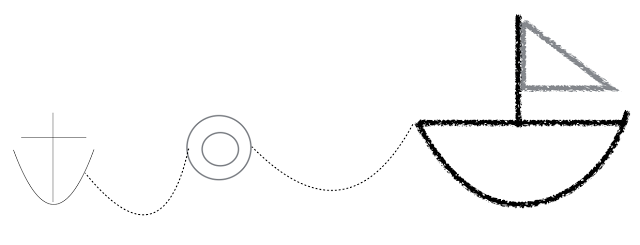 |
| Anchor chain to tire, line from sailboat to tire. The tire takes the impact. |
note 2:
Never trust just your windlass. Always use a 2nd spot on your boat to “anchor” your line. i.e. tie to your cleat and then to your winches, they are well grounded and give you a backup in case your cleat rips out.
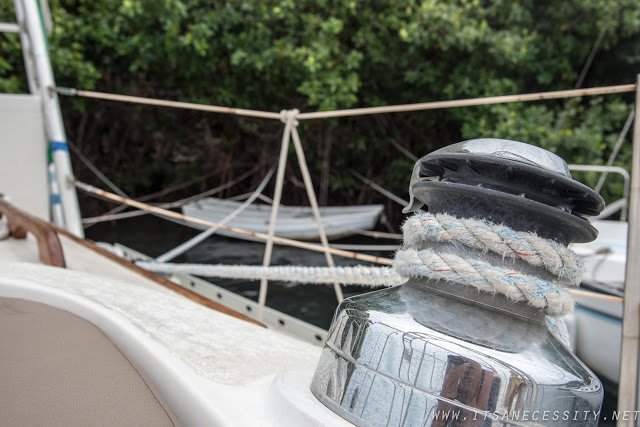 |
| Used our winches as “secondary anchor” for our lines. |
Lines, Ropes, ETC. What You Use To Tie Up.
Let me start by saying that Eben is a packrat. Extra ropes are one of the things that he has the hardest time parting with and I am always on his case to just throw them out. In this instance I was happy we had all those extra ropes onboard!
Brand new lines would be safest and ideal. The older the line the more UV damage it may have, and the more stresses it has gone through. You must find your personal balance of Your Safety vs Your wallet.
Brand new lines would be safest and ideal. The older the line the more UV damage it may have, and the more stresses it has gone through. You must find your personal balance of Your Safety vs Your wallet.
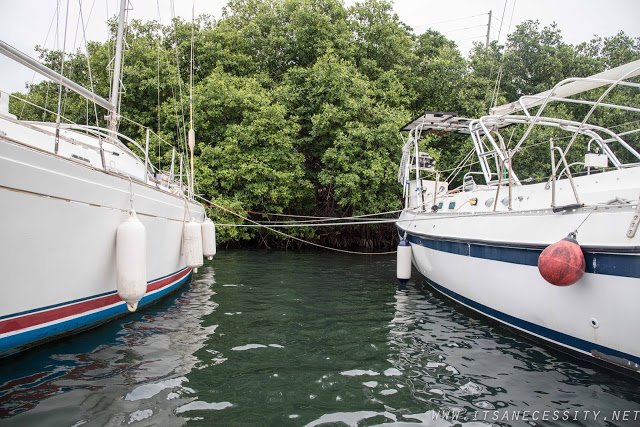 |
| Glad we had enough lines to create this spiderweb. |
To tie in to the mangroves you want to have 4-6 lines of good length (I will give an equation later for that length). With 4 lines you want 2 tied off at midship (one on each side) going out at about 45 degrees and tying in to the mangroves. Then 2 more coming off your stern or bow (which ever you have driven into the mangroves) crossing each other and going into the bush. If you have an other 2 lines on hand use them as well and tie them off your mangrove end shooting off 45 degrees into the mangroves as well.
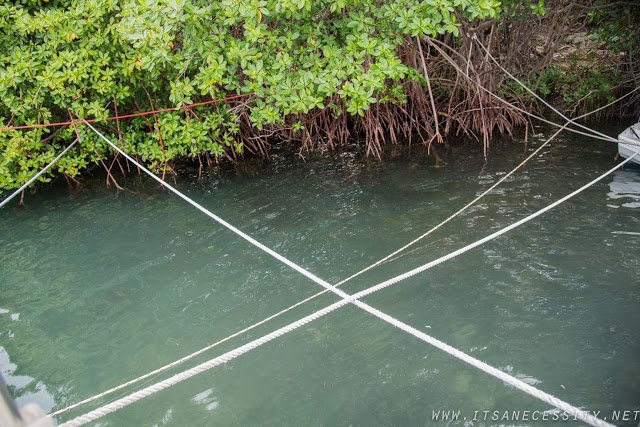 |
| Our stern lines crossing and into the mangroves. |
We have a 41ft boat and used 3 strand, 3/4inch line (because that is what we had on hand).
You need the line to do the length of your boat (either from midship or mangrove end) into the mangroves with 10-20ft of length left on the one end to tie into the mangroves, and 3-5ft on the bitter end after you have cleated off to your boat. The extra on the boat side is to ensure that you can loosen or tighten your lines as the surge comes in or out.
To tie off in the mangroves we found the “knuckles” of the tree (a large branch where lots of little ones split off from there), wrapped our line around it twice so it doesn’t slide around and tied it with a bowline knot.
Eben, who is extra precautious did the double wrap, then a half hitch, then a bowline knot.
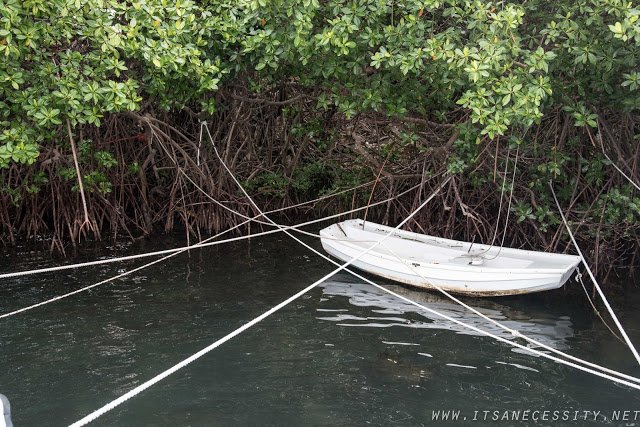 |
| Tying in to the mangroves. |
equation for line length = 5ft to hitch to boat + length of boat + distance to mangroves + 15ft to tie off to branches.
Loose lines vs tight line
Will you be staying on your boat during the storm or will it be left unattended.
If the tidal change isn’t huge, which it isn’t in most of the Caribbean, and you will be on your boat to monitor, we would recommend to err on the side of tight. This gives less time for the boat to gain speed in any one direction and cause high impact on the one rope.
Ropes snap easier when pulled quickly. Pretty sure that’s true, haha.
You will also be around to make any adjustments to them if need be.
Your lines should be on the loose side if your boat will be unattended; to be able to deal with the incoming surge.We also put chafe guards. They didn’t do much but they are there to prevent unnecessary wear, which in the end saves us money. Eben had made our chafe guards out of old fireman’s hose (they have to throw it out regularly to keep up with regulations). Just make sure that they are not completely sealed at the ends, to let rain water flow in freely and help reduce heat and lines melting.
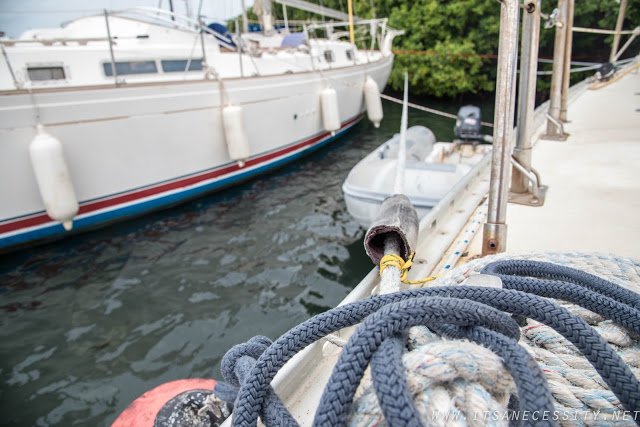 |
| chafe guards. |
 |
| Couldn’t quite get the 45 degree angle because the boats were packed in there so close, so we did what we could. |
Don’t Get Lazy
Prep AT LEAST a full day in advanced.
If you really want to be prepped “properly” for the storm, make sure its all done well in advance. It will take longer to do than expected; it always does on boats.
Get a spot, tie your lines, and set your anchor. Then tie everything on deck down, take down all canvas, sails, and anything that would cause extra windage. Stow all extra stuff below. For larger items, like your dinghy and SUP, find somewhere on land to keep them or tie them into the mangroves too.
Keep in mind that prepping does not only mean your stuff. Prep your mind for all possible scenarios.
Eben says, “ Assume that any one line breaks, what is your boat going to do? What are you going to do? Play the scene out in your head and try and predict what will happen. Have a plan for that. Befriend those around you. You may need a helping hand, or an extra anchor.”
And to wrap up, help everyone you can before the storm, something about getting good Juju!


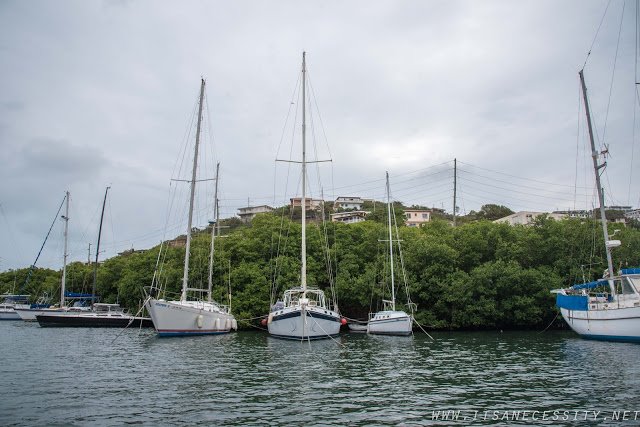


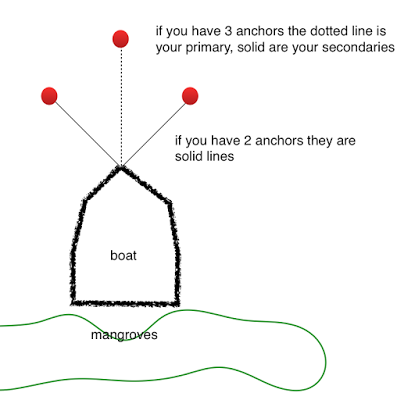
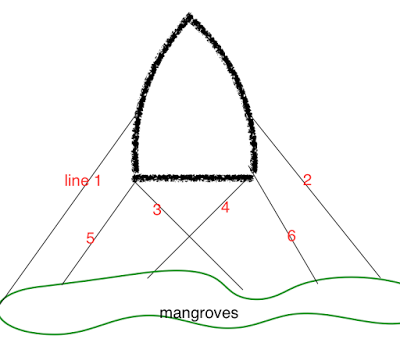



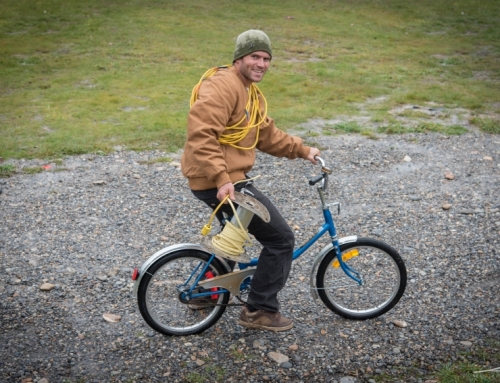
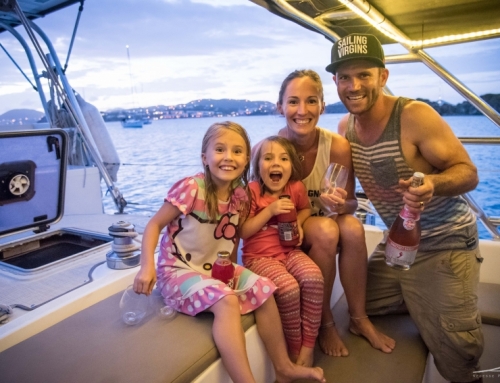
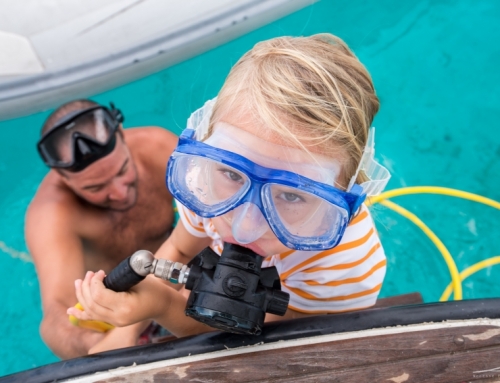
Great info… thanks for sharing!! (and for correcting the bit about the minimum 3" diameter line) 😉
Thanks. I laughed when I saw that typo. My brain was full of different info that 3/4 3 strand turned into 3"!
Great info!
perfect, glad it was helpful
Thanks for the info
you’re welcome.
How did everyone do during Irma? I hope all went well.
Donna
Point Pleasant, NJ
Thank you for your concern Donna. Eben safely weathered Irma with friends. A few days after the hurricane they sailed to Puerto Rico, for multiple reasons. But then Maria was heading their way. One hurricane was enough for my stress levels, and Eben’s!!!, so we got him a flight out. He is currently back in Canada with us, and we are waiting to see what our next steps are as all of our plans have been put on hold.